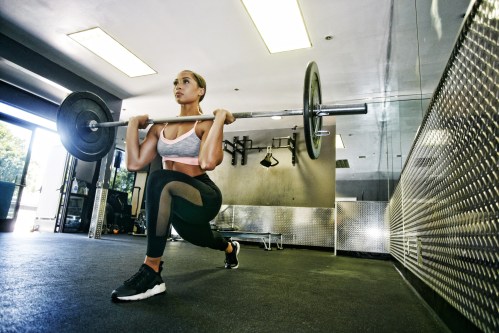The smartest ways to warm up for strength training, according to fitness pros
If you're just hitting a cardio machine before weight training, you're doing it wrong. Fitness pros explain a proper weightlifting warm up to do instead.

Raise your hand if your leg day or arm day warmup consists solely of hitting some kind of cardio machine. Without fail, when I’m prepping for strength training, I always do a little low-and-slow walking, jogging, or spinning to get my body geared up and ready to go. But as it happens, a weightlifting warm up shouldn’t consist solely of cardio.
Think about when you go to a group fitness class: The warmup isn’t just jogging in place. You do moves like leg swings and butt kicks to get your muscles warm. “A lot of people will just walk on a treadmill and feel like because their body is warmer, that has prepared them,” says Heather Milton, an exercise physiologist at the NYU Langone Sports Performance Center. When you strength train, however, you should be intentionally targeting specific parts of the body so that you “are actually warming up the specific muscles that you would need to be working for the given exercise,” she says.
Before you head to the weight rack, plan on spending five to 10 minutes ahead of time stretching and prepping the body to feel loose and like you can move through a full range of motion. Then, check off these top tips for a weightlifting warm up, straight from pro trainers.
1. Mimic similar movements in your weightlifting warm up
Cameron Apt, the director of Athletic Performance Services at the University of Rochester Medical Center, says your biggest pre-workout focus should be mimicking the movements you’ll do during your exercise. “You move through some of the patterns without the load so your body gets used to it,” says Apt. For example, if you’re going to be doing some weighted squats, you can start first by doing some free squats to get used to the motion. “You’re priming your body and your joints to get used to that correct form before you jump into heavy weights.”
2. Keep your stretching dynamic
There actually should be a good amount of cardio present in your warmup (though, yes, the treadmill can have a rest). According to Milton, you should do dynamic stretching, which essentially means you’re moving through a motion to warm up the muscles instead of holding a static stretch. “When you hold a static stretch, it actually down regulates the nerve conduction to the muscle,” she says. “You’re not activating the muscles that you want to be very active when you’re doing the exercise.” Keep static stretching for your cool down, and instead opt for stretches that move your body and get blood pumping for what’s ahead.
3. Always warm up your core
Warming up your core is super important in weight training. Say you’re doing an overhead shoulder press—Apt says that in addition to warming up your shoulders, you need to warm up your core so it can stabilize you to maintain proper form. “If you don’t have full shoulder range of motion, oftentimes you see people arching their backs,” says Apt. “So now, it means you’re using different muscles and you’re not stabilizing correctly through the core,” which he says makes the move less effective.
To warm up your upper body and core, Milton recommends starting on your knees, with your hands under your shoulders. Beginning on the right side, place your arm up, diagonally to create a half ‘Y’ position. This fires up your traps, which you’ll need during chest presses or lat pull-downs. To get into the rotator cuff, take your arm from that half ‘Y’ and cross it over to your left hip. Milton says you’re also warming up your core in this position because you have to engage it to keep proper form.
4. Warm up the ankles for any standing move
Make sure to pay attention to warming up your ankles when working with weights while standing. Milton says it’s key because you use them during lower-body exercises like lunges, squats, and step-ups. To do this, start on one knee with the other leg in front (hips, knees, and ankles all bent at 90 degrees) and move between leaning forward pressing your front knee over your toes (keeping your front heel pressed into the ground) and then sending the hips back, flexing your front foot and stretching the hamstring. Then, you’re ready to get on to the good stuff. Happy lifting!
Take your strength training to the next level by slowing down and approaching it the same way you would a yoga flow.
Sign Up for Our Daily Newsletter
Get all the latest in wellness, trends, food, fitness, beauty, and more delivered right to your inbox.
Got it, you've been added to our email list.










